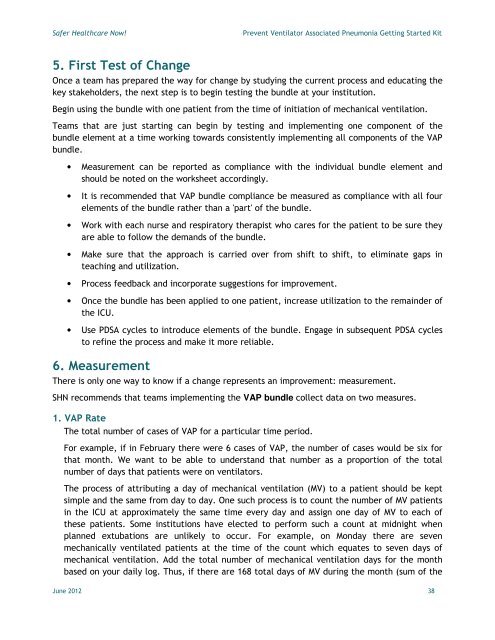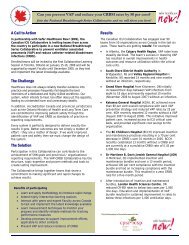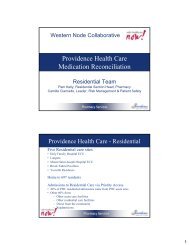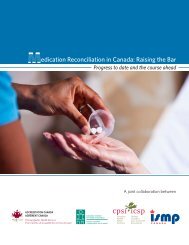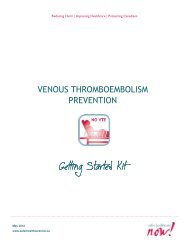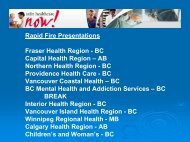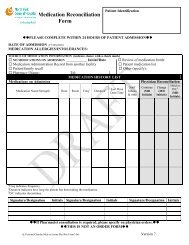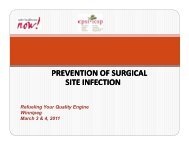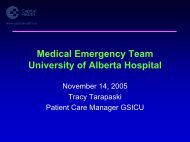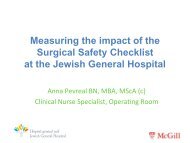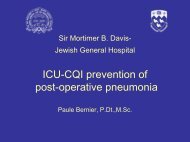VAP Getting Started Kit - Safer Healthcare Now!
VAP Getting Started Kit - Safer Healthcare Now!
VAP Getting Started Kit - Safer Healthcare Now!
You also want an ePaper? Increase the reach of your titles
YUMPU automatically turns print PDFs into web optimized ePapers that Google loves.
<strong>Safer</strong> <strong>Healthcare</strong> <strong>Now</strong>! Prevent Ventilator Associated Pneumonia <strong>Getting</strong> <strong>Started</strong> <strong>Kit</strong><br />
5. First Test of Change<br />
Once a team has prepared the way for change by studying the current process and educating the<br />
key stakeholders, the next step is to begin testing the bundle at your institution.<br />
Begin using the bundle with one patient from the time of initiation of mechanical ventilation.<br />
Teams that are just starting can begin by testing and implementing one component of the<br />
bundle element at a time working towards consistently implementing all components of the <strong>VAP</strong><br />
bundle.<br />
• Measurement can be reported as compliance with the individual bundle element and<br />
should be noted on the worksheet accordingly.<br />
• It is recommended that <strong>VAP</strong> bundle compliance be measured as compliance with all four<br />
elements of the bundle rather than a 'part' of the bundle.<br />
• Work with each nurse and respiratory therapist who cares for the patient to be sure they<br />
are able to follow the demands of the bundle.<br />
• Make sure that the approach is carried over from shift to shift, to eliminate gaps in<br />
teaching and utilization.<br />
• Process feedback and incorporate suggestions for improvement.<br />
• Once the bundle has been applied to one patient, increase utilization to the remainder of<br />
the ICU.<br />
• Use PDSA cycles to introduce elements of the bundle. Engage in subsequent PDSA cycles<br />
to refine the process and make it more reliable.<br />
6. Measurement<br />
There is only one way to know if a change represents an improvement: measurement.<br />
SHN recommends that teams implementing the <strong>VAP</strong> bundle collect data on two measures.<br />
1. <strong>VAP</strong> Rate<br />
The total number of cases of <strong>VAP</strong> for a particular time period.<br />
For example, if in February there were 6 cases of <strong>VAP</strong>, the number of cases would be six for<br />
that month. We want to be able to understand that number as a proportion of the total<br />
number of days that patients were on ventilators.<br />
The process of attributing a day of mechanical ventilation (MV) to a patient should be kept<br />
simple and the same from day to day. One such process is to count the number of MV patients<br />
in the ICU at approximately the same time every day and assign one day of MV to each of<br />
these patients. Some institutions have elected to perform such a count at midnight when<br />
planned extubations are unlikely to occur. For example, on Monday there are seven<br />
mechanically ventilated patients at the time of the count which equates to seven days of<br />
mechanical ventilation. Add the total number of mechanical ventilation days for the month<br />
based on your daily log. Thus, if there are 168 total days of MV during the month (sum of the<br />
June 2012 38


